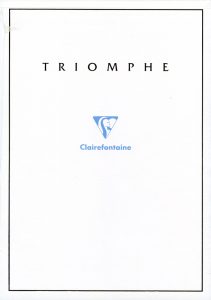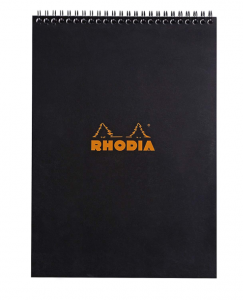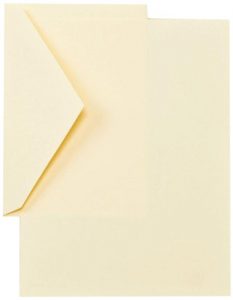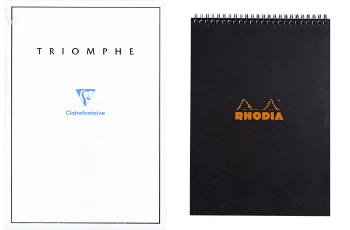While a fountain pen will write on virtually any reasonable paper, that does not mean that paper is the best paper for fountain pens. Some allow the pen to write smoother, some let the ink feather more than others, and some take forever to dry.
Ideally, the best paper for fountain pens is one that is very smooth, keeps the ink lines nice and tight and dries very fast. Unfortunately, this is not really possible. It is like saying you want your car repairs cheap, fast, and correctly. You can usually have two of the three but getting all three at the same time is virtually impossible.
I started like most other people, with a spiral binder and copy paper. Neither of these was the best paper for fountain pens although they both worked well enough to get started. My first introduction to real writing paper was at a pen show where they had a few different types of paper and I picked up some small pads of different types to take home. I really liked these papers and kept my eyes open around town while out shopping to see what else I could find.
What I noticed was that some of these brands were also available in art supply stores and office supply stores, usually in far fewer varieties than I could get at a pen show or online. It was still nice to see them in the wild. There are two in particular that seem the best paper for fountain pens.

My personal favorite is Clairefontaine which makes a wide variety of tablets, notebooks, pads, and other paper products. Of all these products I seem to like the Triomphe blank writing tablets which come in a couple of different sizes. I tend to keep both the larger and smaller ones for different types of writing.
The larger of the tablets usually runs around ten dollars which aren’t terribly expensive but it sure is substantially more expensive than the standard Amazon Basics 8.5″x11.75″ Pack of six tablets which is around twelve dollars (hint, this is NOT the best paper for fountain pens). So why so much more?
There are a lot of reasons starting with the paper being whiter with cleaner, clearer, and slightly fainter rules. This really makes your ink colors jump off the page. Why in the world would you spend money on that fancy pen, load it with Noodler’s Apache Sunset ink, and then write on a drab almost gray sheet of paper?
Clairfontaine Triomphe is also substantially smoother paper with less loose paper fibers. This allows your pen to just glide across the page with virtually no effort. It also keeps your nib cleaner since there is less of the fibers that can break off and get hung in your nib. A cleaner nib also helps with a smoother writing experience.
One thing that annoys me that may not affect you is show through. When I am selecting the best paper for fountain pens I want to see as little writing on the backside of the page as possible. First, if I only use one side of the page it looks infinitely neater when the backside is clean. Second, if I want to use both sides of the page then seeing one side on the other is just messy looking and in my opinion, tacky. Fortunately, there is very little show through even with dark inks.
Lastly is the ink tends to stay in nice sharp lines instead of feathering out much. Basically feathering is when you look closely at a line you made on the page and you can see the ink soaking into the paper on the sides of the line creating what appears to be a rough edge similar to the edges of a feather. Even looking at the page from a distance of a couple of feet you can clearly see the text is sharper on the page than with other papers.
I have tried a lot of papers over the years, and to me, the best paper for fountain pens is Clairefontaine Triomphe.

Some people think the best paper for fountain pens is one that is a little less slick, a little less in your face, something that is more of a well-rounded paper instead of one specifically made for fountain pens, that would be Rhodia. Anyone who has ever walked the isles at an office supply store or an art supply store will immediately remember seeing their distinctive orange covers.
My favorite for writing with Rhodia is their spiral-bound notebooks, probably because it is made with Clairefontaine paper and very well bound. It also has a really nice micro-perforations across the top making it really nice and smooth to remove from the tablet.
So wait a second, did I just say the Rhodia used Clairefontaine paper, was spiral bound, had micro-perforations, and yet I rank it below the Clairefontaine tablets above? Yup. Because Clairefontaine makes different papers and the Triomphe is in my opinion superior to the 80g vellum they put in the Rhodia tablets.
Now I want to be very clear here; not only is this distinction very personal, but it is also very minor. I have never, ever, been disappointed with a Rhodia product of any kind. If I needed a tablet and I happened to be in an office supply store that only had Rhodia, would I walk out and buy some Triomphe online? No. If I knew the art supply store right next door had Triomphe tablets would I walk next door to buy them over the Rhodia? Yes.
To me, the paper used in the Rhodia is just a tad less smooth, and a tad less bright. I get a better feel using the Triomphe over it. Using a ballpoint or pencil I think I can feel a difference but will freely admit that might be my imagination. Show through is about the same on either of these papers.

The next best paper for fountain pens is a little of a different type of paper altogether, Original Crown Mill Classic Laid Stationery. I am particularly fond of the White Classic Line.
This paper is a departure from what we have talked about so far as it is textured. This feels completely different and is not well suited in my opinion to those who have an extremely light touch, or those who like to write with an extra-fine point. That being said, the feeling is unusual and oddly fun.
This paper is heavier than what we have already looked at and seems very fibrous. This gives it a really nice old-world feeling.
For its heft, I see a lot more show-through than I would expect, although it still is not bad at all. In another paradox, given its fibrous appearance, I would have expected some feathering but there is remarkably little to be seen. Yes, the lines are a little less well defined but that seems due to the texture, not from feathering.
Overall this is a fun paper for correspondence, not really something I use for notes, sketches, or serious writing.

I saved one of my favorites for last, Crane stationery. I have never used anything but their stationery and envelopes and honestly don’t know if they make anything else, but their 100% cotton stuff with the kid finish is just amazing. I am particularly fond of their Crane CH3116 Ecruwhite Half Sheets which are just simply amazing. To give you an idea, you know those really fancy and expensive wedding invitations that looked like something from English Royalty? Yeah, that was probably Crane stuff.
One of my favorite things to do when I want some nice stationery is to visit a stationery store and go play with the paper until I find something I really like. A lot of times I find stuff on sale that they are discontinuing or that they ordered too much of and get a great deal on some amazing paper.
This isn’t paper I typically “stock”, this is special stuff I go get and have fun writing letters to friends on.
If I had to use one paper for everything I did, I would honestly probably use the Rhodia spiral since the binding and micro-perforations make it more suitable for carrying around as well as easy and neat removal from the tablet. Fortunately, I can have all three and use them for different purposes.
As it turns out, the best paper for fountain pens depends on what you want to do with it!

